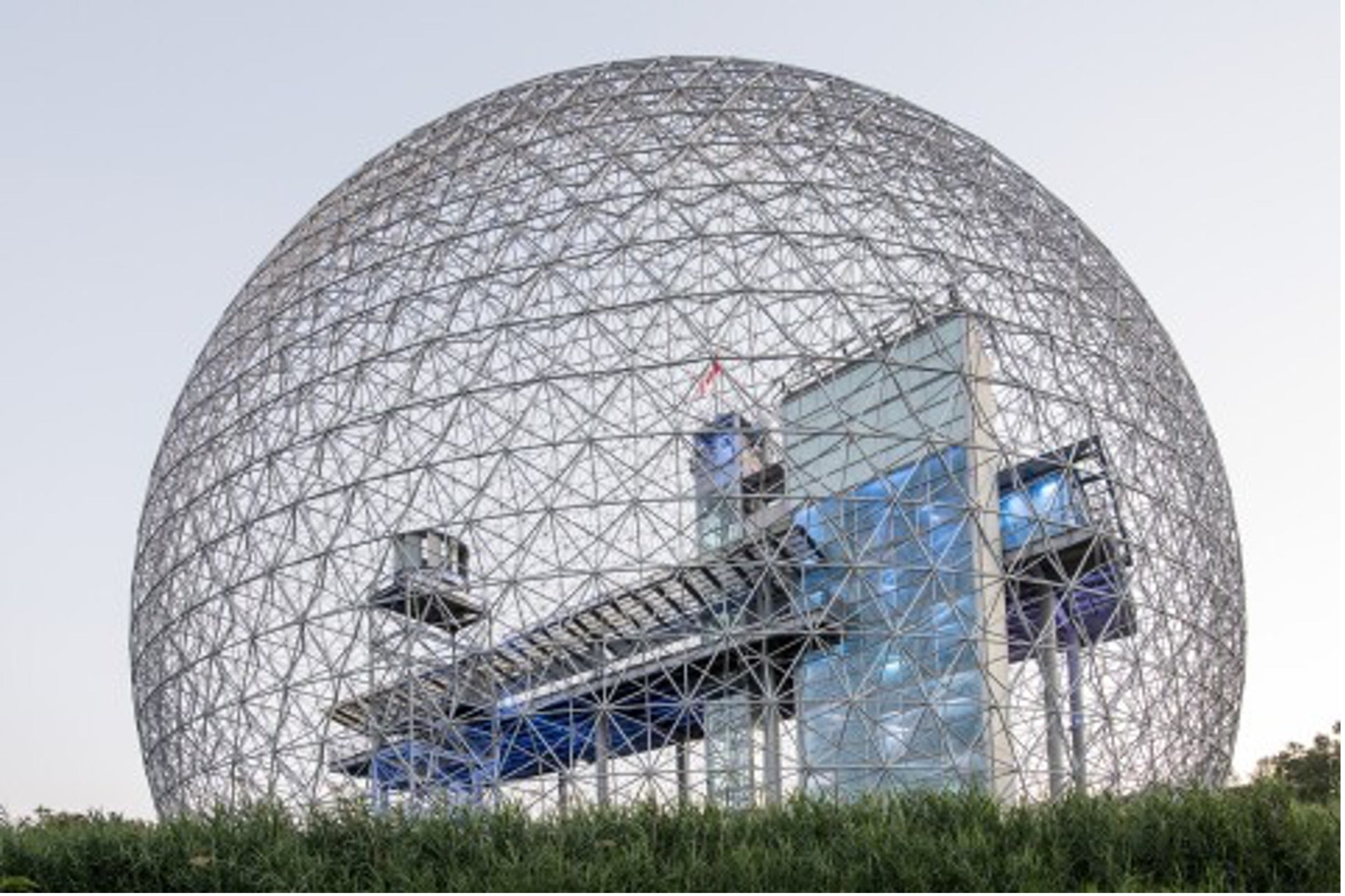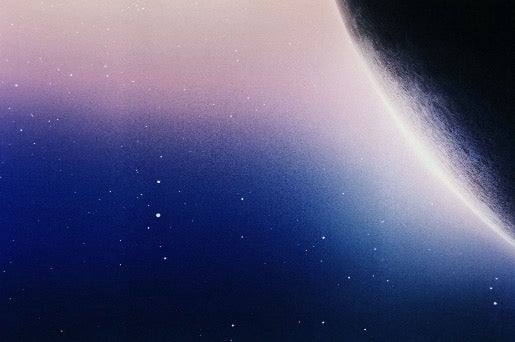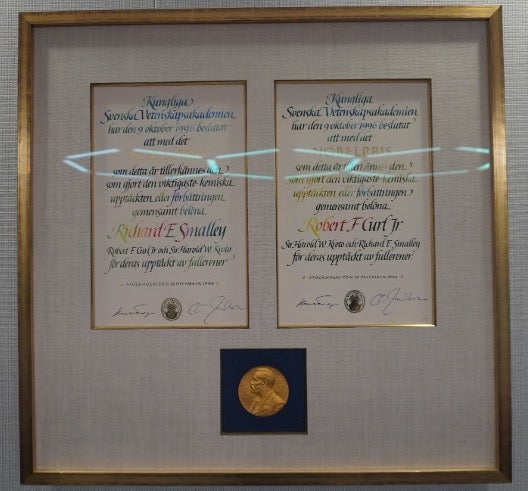“Fortune favors the prepared mind”—A quote attributed to Louis Pascal, the inventor (or discoverer?) of pasteurization. Thanks to this process, one can enjoy a cold glass of milk without the significant disadvantage of dying of Salmonellosis.
This quote summarizes the concept of serendipity: a fortuitous discovery product of perseverance – a clever realization preceded by a chain of lucky events – the product of thinking outside the box, an eureka moment filled with chance.
I interviewed John Marsh, the current administrative director of the Smalley-Curl Institute (SCI). With his unique storytelling style, filled with memorable quotes and fun facts, he related the chain of lucky events, which he heard firsthand from two of the discoverers, that preceded the most important serendipity that has come out of Rice University – the discovery of the 60-atom carbon molecule arranged geometrically in the shape of a football (or soccer ball, in the US.): The Buckminsterfullerene, aka “The Buckyball”—named after the American architect F. Buckminster Fuller.
 Picture description: F. Buckminster Fuller popularized the geodesic dome structure throughout the US
Picture description: F. Buckminster Fuller popularized the geodesic dome structure throughout the US
A series of fortuitous events
This story kicks off with a blend of art and a spark of inspiration. Sir Harold (“Harry”) Kroto, English chemist, getting his creative juices flowing from art, and the artsy images from space dust that got him interested in studying one of the components: carbon molecular clusters. In addition to continuing with research into carbon, his big thing was advocating for science education, and he did this with enthusiasm; producing courses, videos, and programs both in the UK and later in his life at Florida State University.
Enter Richard (“Rick”) Smalley, “the inventor,” with a flair for creating devices that could catch a closer gaze at these carbon clusters.
John: According to people who told me about Rick, he was a builder of groups, machines, ideas. At its height, I believe the Center for Nanoscale Science and Technology – the precursor of what is now the Smalley-Curl Institute – had almost all of the third floor of the Space Science and Technology building. It was a shared-use facility: I think that if you were at Rice and had a little funding, and had interesting ideas about nanoscale research, you could come do your thing here. I’m also told that Rick could have very strong opinions and could come across as unkind.
He was partners-in-crime with Robert (“Bob”) Curl, Pitzer–Schlumberger Professor of Natural Sciences and professor of chemistry at Rice.
John: Bob didn’t carry the fascination with carbon that Rick sustained; he did other things and was a productive researcher into his later years, though in his last several years, he may have been more involved in science policy at the Baker Institute than with his lab. Bob was very kind and approachable while maintaining a sharp scientific mind. Bob and Rick had very complementary personalities. I did have the opportunity to get to know Bob, a bit. He lived in the neighborhood across Rice Blvd. from campus and biked to work every day. I used to drive a big Mercury Marquis that my dad had given me, and once I told Bob: “One of the things I worry about is that, someday, I might run over you on your bike when I'm driving out of Entrance 20.” Bob said, “Well, if it’s my time, it’s my time.”

Photo Description: Nasa Artemis mission display – Alan Covarrubias.
Initially, Rick wasn’t exactly jumping for joy over researching carbon. He was focused, at the time, on metallic clusters. Later, after the buckyball discovery, he was heard to say he had become a “carbon bigot.” But after several tries, Harry persuaded Rick, through Bob, to do a short project on carbon clusters.The group found a little funding and got together – for just a week or two – in the summer of 1985. They were an odd trio: Rick, with his driven and incisive personality; Harry, with his inspiration from both art and science; and Bob, a more reserved personality with a sharp scientific mind, and well-known for his kind-hearth and patience.
John: That's the magic of innovation, isn't it? Having folks who are worlds apart collaborating to approach a common goal.
A clever realization
After some back and forth, they rolled up their sleeves and dove into the experiment. They aimed to mimic the infrared emissions of a celestial body—a red carbon star. Employing the laser vaporization technique Rick had been using to study metallic clusters, they accidentally stumbled upon the method for generating fullerenes when they aimed that laser at graphite. The cosmic-inspired quest led them not to the stars but back to the very building blocks of life on Earth: carbon atoms.
Sifting through the results, a grad student's eyes popped at the sight of a never-seen-before peak at 60 atoms in the time-of-flight mass spectra. This definitive peak, showing a cluster of 60-atom carbon molecules, forced the group to shift away from space dust and toward figuring out what these molecules looked like. With this specific number of atoms, the group believed that the molecule simply had to be a structured and discrete shape.

Image caption: Time-of-flight mass spectra of carbon clusters under different pressure levels. A peak at 60 carbon atoms is clearly visible.
As happens in fully collaborative discovery, there may have been many threads that led the group to settle on the now-iconic shape. In his visits to Rice in more recent times, Sir Harry said that he knew there was something at his home in the UK that suggested this shape. Still, he couldn’t necessarily call it to mind until later: it was a star map, arranged as a spheroid geometric solid…with hexagonal and pentagonal faces.
The “AHA!” Moment
Whatever part of the group’s discussion inspired it, though, Rick spent one night at home with scissors, paper and tape, and began crafting hexagonal and pentagonal shapes. He began taping these shapes together until he arrived at a spheroid figure with exactly 60 junctions, representing the atoms, and with the joined edges of each piece representing the chemical bonds. Once the group saw this shape the next day, they said “that HAS to be it.” They soon left a message with the math department – hoping for illumination from the theorist’s light.
Sadly, Rick was not the kind of guy who would bother keeping concert tickets or old love letters. Mementos? Pfft. Not his thing. So, in a plot twist that surprises no one, the original paper shape replicating this monumental discovery got lost in time. Oh, Rick, if only you'd known how precious (and valuable) that piece of paper would become!
As Bob Curl related the experience, years later, the group got a call back from one of the math faculty, who said something like “What you have discovered is a soccer ball—and the Greeks have known it for only about 2000 years, as a truncated icosahedron.” But this was the first molecule discovered with this shape!

Picture description: The truncated icosahedron is an Archimedean solid of 32 faces, 12 pentagonal and 20 hexagonal faces
And there it was, the “AHA!” moment that turned the Buckyball, into a topic of conversation, an exemplar of innovation stemming from art inspiration. But, as with any groundbreaking discovery, controversy wasn't far behind it.
John: If it weren’t controversial, it wouldn’t be new. Of course, the idea was challenged: that’s the way science is supposed to work.
The true test? Replication. And when other research groups successfully replicated it, the reality of their discovery was undeniable. The most beautiful molecule1 came to life.
The Aftermath
Picture this: a dash of inspiration, a pinch of persistence, and a cup of preparation—all seasoned with a fistful of fortuitous events and voilà! You've got the recipe for discoveries that change the world: the fantastical science stew.

Picture description: Vintage kitchen measurements
Because of this fantastic discovery, Rice is considered by many the birthplace of carbon nanotechnology. Only 11 years after their momentous discovery, the Nobel prizes Committee had finally honored Rick, Harry, and Bob by awarding them the 1996 Nobel Prize in Chemistry. This event led to the establishment of what is now the SCI, the host of the Applied Physics Program, the Rice Quantum Initiative, the Rice Center for Quantum Materials, and the organizer of multiple events – including the 38-years-and-running annual SCI Summer Research Colloquium, and other world-leading workshops – especially, these days, in quantum research.
The institute continues carrying forward the mission of international and inter-institutional collaboration. Meanwhile, Rice’s influential Carbon Hub – ably led by Prof. Matteo Pasquali – is a direct intellectual descendent of the buckyball discovery.

Picture description: The Nobel Prize – securely but proudly displayed in the SCI offices – serves as an inspiration for the grand scientific endeavors at Rice, a breeding ground for “prepared minds.”
Whispered among the halls of the SCI, there's a prophecy that Rice University is destined for another Nobel Prize—’tis just a matter of time.
You can read the original two-page article describing the experiment and its results here.
—-------------------------------------------------------------------------------------------
1 A must-read book if you want to know more about this story is “The Most Beautiful Molecule: The Discovery of the Buckyball” by H. Aldersey-William.
Author’s footnote: I am thankful for the invaluable feedback and many corrections provided by John, as well as for his devotion and patience in telling the story multiple times to the author!
About the author:
Alan earned his Bachelor’s Degree in Applied Physics from the Benemérita Universidad Autónoma de Puebla (BUAP) in Mexico in 2023. His previous research focused on computational physics and model simulation of both quantum and classical systems. Currently, Alan is engaged in the realm of engineering quantum vacuum fields to control the properties of quantum materials using terahertz radiation technology. Read more.
Further Reading:
A taste of Africa in Houston: Discovering African Markets around Rice University
Why I Chose Rice for Graduate School
